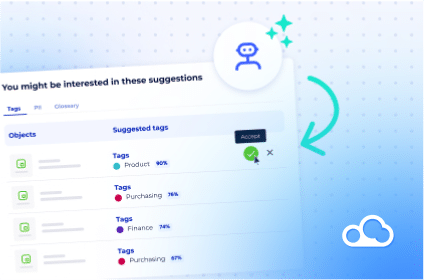Does your company need a data catalog? Data catalogs have become essential for improving data quality, access, and insights for businesses of all sizes. Data catalogs provide a comprehensive view of a company’s data assets. Modern catalogs identify where data comes from, who produces it, and how and where it flows through an entire organization.
Data catalogs provide easy access to information for business intelligence, data teams, and IT, and with companies practically drowning in information, they offer an automated solution for data lineage, governance, and other aspects of data management.
Businesses are collecting and analyzing more substantial amounts of data than ever. And there’s little question that yours would benefit significantly from a data catalog. A more practical question might be whether your company should attempt to build a catalog or buy a proprietary one.
DIY or buy: 4 points to consider
From start-up to maintenance, there are four essential factors to consider when deciding to DIY or buy a data solution.
#1: Build-capable technical expertise & leadership
Complex IT solutions require specialized skills and knowledge that even the most talented in-house IT professionals may not have. Additionally, dedicated leadership is needed to organize and direct a team. Significant investment in people and resources will be necessary to ensure your project remains on budget and on time.
Companies needing a data catalog are likely already challenged to support existing needs. Adding a complicated and time-intensive project can drain resources from other critical initiatives. It can also result in costly delays to current workstreams. Using an established solution from an experienced merchant brings distinct advantages over home-grown projects. These advantages include technical expertise and professional integration.
Experts deployed to support the installation of a custom catalog can ensure a smooth and efficient project. With precision skills and deep project management experience, vendors provide proven leadership. And as subject matter experts, they are uniquely positioned to overcome common and unusual obstacles.
Vendor teams consisting of product experts and trainers offer extraordinary value to your data, IT, and BI teams. From initial planning to execution, your company will be guided and supported to a successful and timely conclusion.
#2: Start-up cost & timelines
Your start-up costs will require budgets for data engineers, software, and other soft costs. Personnel expenditures will likely increase depending on the number and quality of the data engineers you can commit – or hire – while in start-up mode.
Start-up labor costs will also rely on your organization’s size and complexity. The greater the task, the more people and time your project will require. Even a highly skilled team of 3-6 engineers can run companies deep into six figures in start-up costs alone. Furthermore, initial costs can be far higher if outside consultants are necessary to get your project off the ground.
Timelines for completion will again depend upon the number of people committed to the project, and even a small business could find that three to six months, or more, may be necessary to complete the task.
Moreso, an organization’s time and financial investment in building a catalog come without the guarantee of success in the end. The risk of conflicting priorities, indecision, or other impediments can quickly derail progress.
A tailored product from a reputable seller can save organizations significant time and money. Receiving a fully managed solution allows companies to focus on their core business. At the same time, their data catalog is built and delivered by a dedicated team of professionals.
Using an existing data catalog solution will reduce implementation times significantly. With a vendor focused exclusively on your data catalog build, distractions are minimal. With extensive experience gained through many installations, stated timelines are accurate and reliable.
#3: User experience
Constructing a user interface for a homemade data catalog isn’t rocket science, but it’s certainly not easy. Depending on your IT team’s size and skill set, you might have UI experience to draw from, but that’s only half of the equation.
An internal approach to data catalog design may not result in a modern catalog interface. Moreso, they may need to learn what’s now possible in an advanced interactive and intuitive interface.
Professional data catalog tools deliver more than just the basics of cataloging your company’s data. Skilled UX teams design these products to support business intelligence users intuitively. These UI experts ensure that your analysis teams get maximum value from their enterprise information.
Following the deployment of a solution, continued support for your data catalog is vital. A vendor offering a service component adds substantial value. They instruct and assist clients with best practices and proper use of their new data catalog. This sustained partnership ensures your company understands a data catalog’s full power and scope, and it allows your teams to leverage all your tool’s capabilities right from the start.
#4: Managed services
A successful self-made data catalog build is only part of your efforts. Adopting and integrating a robust data catalog is just the beginning of a company’s journey to improved data integrity. Ongoing support and maintenance will be crucial for its long-term health and viability. A dedicated and capable team is essential to ensuring the continued health of your data catalog.
Software updates, troubleshooting, and routine maintenance are necessary to sustain your investment, and as employee additions and turnover occur, the need for training and support will continue.
Partner solutions include an easily accessible team of specialists supporting your organization’s program. This team ensures that appropriate resources are always available to maintain or scale your program.
While this support comes with a cost, subscription fees are far less than permanent headcount on a company’s bottom line. Leveraging these resources as needed is a cost-effective and scalable approach as needs expand and contract over time.
Conclusion
The conclusion is unmistakable when calculating the costs of building or buying a data catalog. Buying a custom-designed solution is the most cost-efficient way to acquire a full-service data catalog.
Partnering with experts for your data catalog offers your organization every possible advantage: Professional integration. Training. Maintenance and Support. Your IT, Data, and Business Intelligence teams require a quality data catalog to become a truly data-driven organization.
While building a basic catalog is possible, finding the people and resources to build one from scratch is a monumental challenge. The costs to secure consultants and IT professionals and the budget to bootstrap a solution are significant. And hiring extra staff requires considerable effort, particularly in a challenging labor market.
Internal solutions will find it hard to duplicate the dynamic interfaces that today’s products deliver. Data catalogs have advanced far beyond the more fundamental data tools of the past: they have become a data knowledge workplace for metadata mapping, management, and knowledge sharing.
Finally, building a data catalog is just the beginning of an ongoing journey to data discovery. Additional training, upgrades, and scaling will become necessary as your teams and business evolve. Capitalizing on the expertise of an established data catalog provider makes sense. These thought leaders offer support and alignment with industry insights and best practices that are difficult to match. There’s no debate for companies committed to extracting maximum value from their business data. Selecting a proprietary catalog supported by a team of industry specialists is a wise choice over any DIY solution.
Are you ready to take the next step in your data catalog journey? Connect with one of our experts today!





